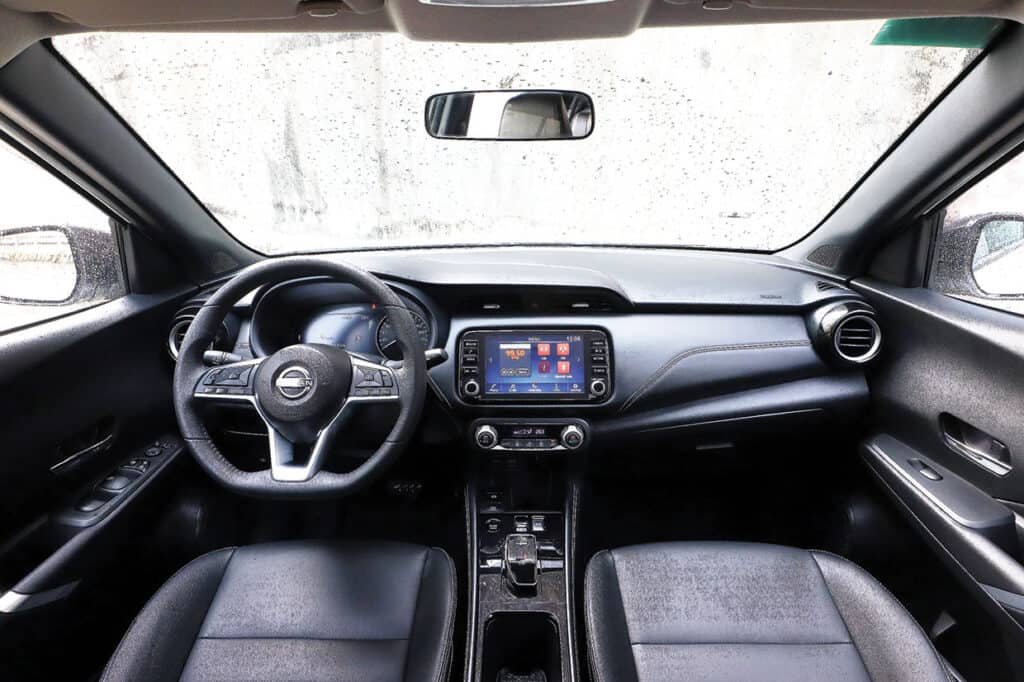Among small SUVs, the Nissan Kicks e-POWER has caught the attention of people for one thing: its all-electric powertrain. Initially, there’s been some confusion on the role of the onboard combustion engine (we’ll get to that later), but the fact of the matter is, it’s the only one in its class to be powered solely by an AC synchronous motor. As such, there’s no denying that it delivers a great drive. However, at the same time, it’s saddled by a package that’s run-of-the-mill everywhere else.
Competing in a class populated by the likes of the Mazda CX-30 and Toyota Corolla Cross—both of which come with either a standard or optional hybrid powertrain, the Kicks comes out looking “okay.” It sticks to the Nissan corporate look, but there are some playful touches here like the D-pillar kink, two-tone color scheme, and full-width taillight cluster. Often overlooked details too are also the silver-colored roof rails which happen to perfectly match the silver-trim on the bumpers and side sills.
“Alright” as the Kicks is outside, the interior feels very econo-car. Despite its P1.509-million price tag, the choice of materials could have been better. With the exception of a padded insert in the middle of the dash, everything else is made of hard, hollow plastic. Thankfully, the switchgear is well-wearing and operates with a nice, crisp feel. In addition, the use of large knobs and rocker switches improves the overall usability.

On the subject of usability, ergonomics is a high point for the Kicks. The steering wheel offers a good level of adjustment as do the 6-way manually adjustable seats. Nissan has implemented some high-tech touches in here like the partial digital driver’s display and electronic shifter.
As reasonably tech-laden as the Kicks is for the front occupants, the rear passengers won’t be experiencing any of that. There are no rear AC vents or a center arm rest. But at least everyone gets their own 3-point seatbelts, headrests, and there are two USB Type A charging ports. Plus, Nissan’s decision to place the high-voltage battery between the front seats has resulted in an almost flat rear floor.
Just as generous (space-wise) is the Kicks’s cargo hold. It’s on the large end of the compact crossover range, even if it doesn’t fold flush with the rear seats. It’s also worth reiterating that this SUV doesn’t come with a spare tire, be it a conventional or t-type. With the 12-volt battery placed underneath there, there’s just enough space here for a can of sealant and an air compressor.
At this point, it’s obvious that the Kicks is just a run-of-the-mill crossover. But then, it manages to turn things around thanks to basically what you find under the hood. As previously mentioned, there’s a 1.2-liter 3-cylinder motor in there, but rather than providing thrust, it acts solely as a generator to the EM47 electric motor. Related to the one found in the all-electric Leaf (EM57), here it makes 136hp and 280Nm of torque. 0 to 100 km/h takes about 9 seconds, but subjectively it feels faster thanks to its peak figures available from zero rpm and a single-gear transmission.
Around town, the Kicks is perky, with little need to push deep into the throttle to get some shove in. In fact, you can stay within what the instrument cluster labels as the “Eco” zone and you’ll still manage to keep up with other vehicular traffic. There are some instances where the gas engine turns on by itself for a few seconds, but again, that has nothing to do with what your right foot’s doing (it’s more down to the battery’s charge level). As with most EVs, the powertrain is best experienced in the urban confines. Progress starts to slow once the speeds go up.
Nissan has also imbued the Kicks with three driving modes, and unlike Toyota’s Hybrid which is largely a drive-and-forget setup, here, it’s actually key to extracting the most range. Left in “Normal” mode, the fuel economy is rather underwhelming for a hybrid: 13.51 km/L. Switching to “Eco” though happens to bump it up to a more reasonable 16.94 km/L in the city. Ultimately, this is down to e-Pedal Step which aggressively recaptures braking energy to the tune of 0.15 to 0.18 g of force. At highway speeds, the gas-powered generator is almost always switched on (it sends electrical charge straight to the electric motor, bypassing the onboard lithium-ion battery), but still nets an impressive 20 km/L.
Economy and straight-line performance aside, the Kicks is also a tidy handler. It can be surprisingly fun and nimble to throw around at city speeds. It’s no canyon carver, but despite being labeled as an urban runabout, it can eat miles with ease. The steering is light, but offers direct and accurate responses. The suspension is tuned for comfort, and for that, provides a well-cushioned ride. The same goes for the brake pedal which offers a more natural feel despite its regeneration function.
When it comes to safety, Nissan’s quick to add the “Nissan Intelligent Mobility” label on the Kicks. In reality though, it’s severely lacking in driving aids compared to the company’s previous efforts such as the Terra, Navara, and even Almera. You do get forward collision warning, autonomous emergency braking, and a 360-degree camera with rear parking sensors, but that’s it. Looking for lane departure warning or adaptive cruise control or blind spot indicators? Sorry, you’re out of luck. On one hand, it’s so easy to get spoiled with the sort of safety tech you get standard nowadays (some will even argue you really don’t need them), but since Nissan’s made a big deal marketing these figures, at least you’d expect them as standard on this top-trim VL.
Ultimately, Nissan’s decision to withhold key ingredients to the Kicks e-Power holds it back from being the complete compact crossover package. But in the end, there’s no questioning that the EV-like driving experience, even if it’s charged by a gas engine, remains its biggest draw.

